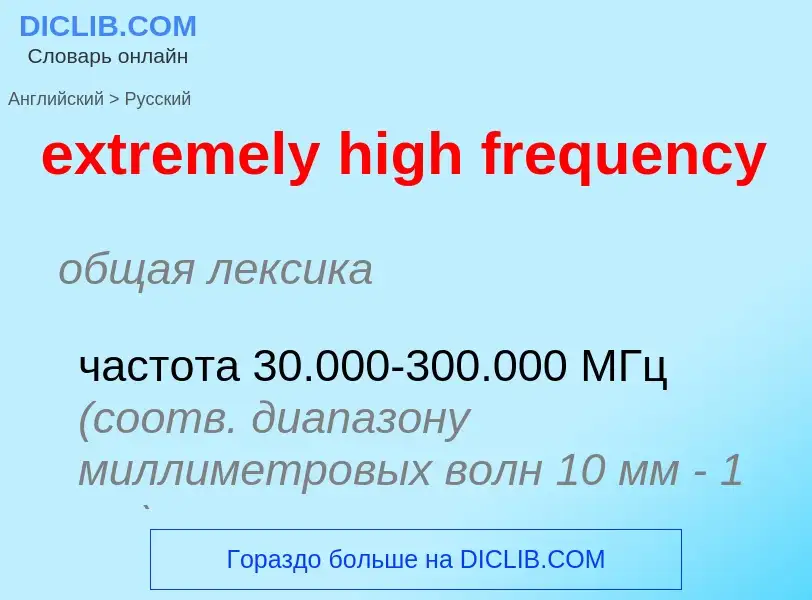Перевод и анализ слов искусственным интеллектом ChatGPT
На этой странице Вы можете получить подробный анализ слова или словосочетания, произведенный с помощью лучшей на сегодняшний день технологии искусственного интеллекта:
- как употребляется слово
- частота употребления
- используется оно чаще в устной или письменной речи
- варианты перевода слова
- примеры употребления (несколько фраз с переводом)
- этимология
extremely high frequency - перевод на русский
общая лексика
частота 30.000-300.000 МГц (соотв. диапазону миллиметровых волн 10 мм - 1 мм)
общая лексика
миллиметровые волны
электромагнитные волны в диапазоне от 300 до 3000 ГГц (т.е. с длиной волны от 0,1 до 1 мм)
Смотрите также
общая лексика
заградитель линейный
Определение
Википедия
Extremely high frequency (EHF) is the International Telecommunication Union (ITU) designation for the band of radio frequencies in the electromagnetic spectrum from 30 to 300 gigahertz (GHz). It lies between the super high frequency band and the far infrared band, the lower part of which is the terahertz band. Radio waves in this band have wavelengths from ten to one millimetre, so it is also called the millimetre band and radiation in this band is called millimetre waves, sometimes abbreviated MMW or mmWave. Millimetre-length electromagnetic waves were first investigated by Indian physicist Jagadish Chandra Bose, who generated waves of frequency up to 60 GHz during experiments in 1894–1896.
Compared to lower bands, radio waves in this band have high atmospheric attenuation: they are absorbed by the gases in the atmosphere. Absorption increases with frequency until at the top end of the band the waves are attenuated to zero within a few meters. Absorption by humidity in the atmosphere is significant except in desert environments, and attenuation by rain (rain fade) is a serious problem even over short distances. However the short propagation range allows smaller frequency reuse distances than lower frequencies. The short wavelength allows modest size antennas to have a small beam width, further increasing frequency reuse potential. Millimeter waves are used for military fire-control radar, airport security scanners, short range wireless networks, and scientific research.
In a major new application of millimeter waves, certain frequency ranges near the bottom of the band are being used in the newest generation of cell phone networks, 5G networks. The design of millimeter-wave circuit and subsystems (such as antennas, power amplifiers, mixers and oscillators) also presents severe challenges to engineers due to semiconductor and process limitations, model limitations and poor Q factors of passive devices.

![A CableFree MMW link installed in the UAE installed for [[Safe City]] applications, providing 1Gbit/s capacity between sites. The links are fast to deploy and have a lower cost than fibre optics. A CableFree MMW link installed in the UAE installed for [[Safe City]] applications, providing 1Gbit/s capacity between sites. The links are fast to deploy and have a lower cost than fibre optics.](https://commons.wikimedia.org/wiki/Special:FilePath/CableFree MMW Link installed in UAE.jpg?width=200)
![Atmospheric attenuation in dB/km as a function of frequency over the EHF band. Peaks in absorption at specific frequencies are a problem, due to atmosphere constituents such as [[water]] vapour (H<sub>2</sub>O) and molecular [[oxygen]] (O<sub>2</sub>). The vertical scale is logarithmic. Atmospheric attenuation in dB/km as a function of frequency over the EHF band. Peaks in absorption at specific frequencies are a problem, due to atmosphere constituents such as [[water]] vapour (H<sub>2</sub>O) and molecular [[oxygen]] (O<sub>2</sub>). The vertical scale is logarithmic.](https://commons.wikimedia.org/wiki/Special:FilePath/Micrwavattrp.png?width=200)
![Part of the [[Atacama Large Millimeter Array]] (ALMA), a millimeter wave [[radio telescope]] Part of the [[Atacama Large Millimeter Array]] (ALMA), a millimeter wave [[radio telescope]]](https://commons.wikimedia.org/wiki/Special:FilePath/The Atacama Compact Array.jpg?width=200)

